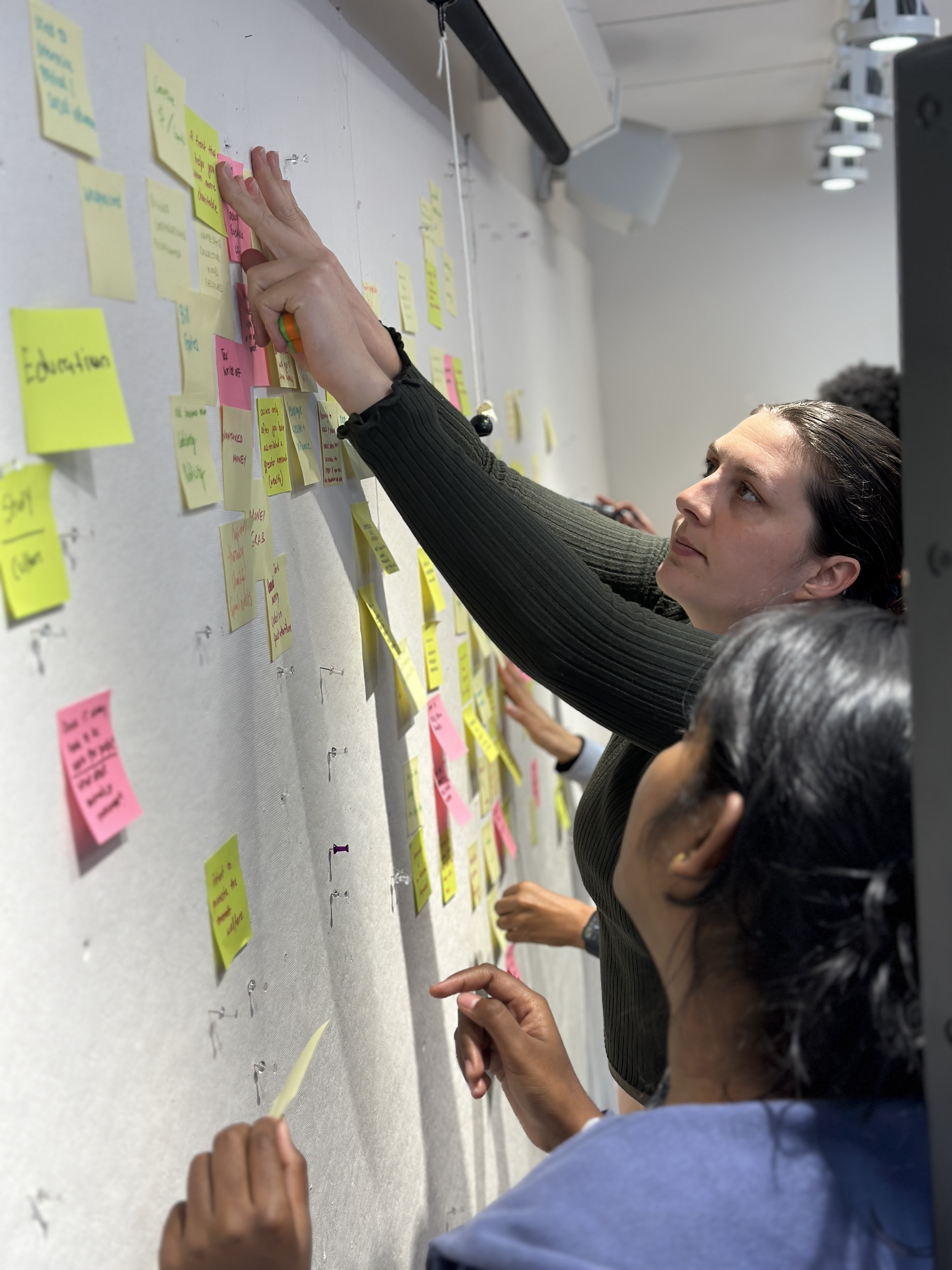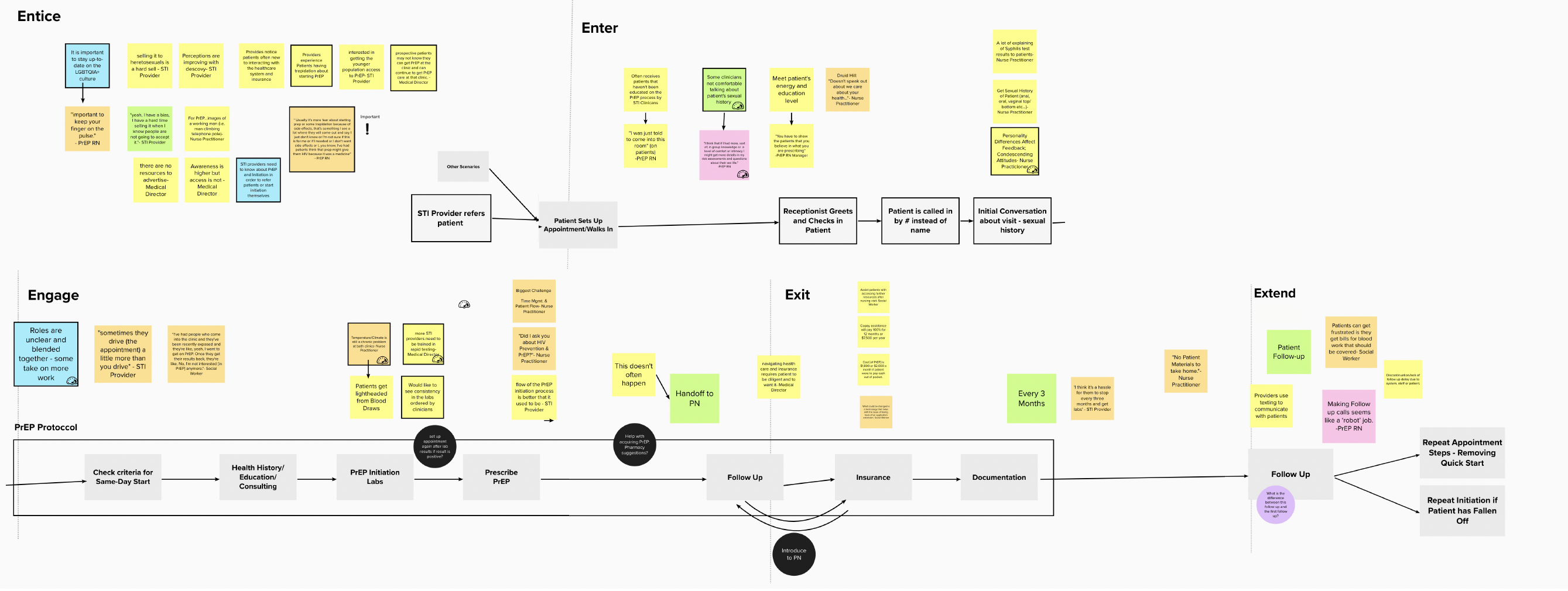Collaborative Research Publication
Beloved Bodies: A Composition of Stories and Resources About Garment-Making
Beloved Bodies is a design research project, and a personal pursuit to answer, “how might we ensure the visibility, safety, and consciousness of the gender expansive community in garment-making?”
This body of work centers the voices of Trans and Non-binary people’s experience around navigating garments and garment-making.
In launching Issue 1, this project kicked off in March 2025 with a community call sent up and down the East Coast calling on designers and the stories for the gender-expansive community.
The creation of this zine was printed and designed at Snakehair Riso Artist Residency in Providence, Rhode Island in May 2025
This body of work centers the voices of Trans and Non-binary people’s experience around navigating garments and garment-making.
In launching Issue 1, this project kicked off in March 2025 with a community call sent up and down the East Coast calling on designers and the stories for the gender-expansive community.
The creation of this zine was printed and designed at Snakehair Riso Artist Residency in Providence, Rhode Island in May 2025










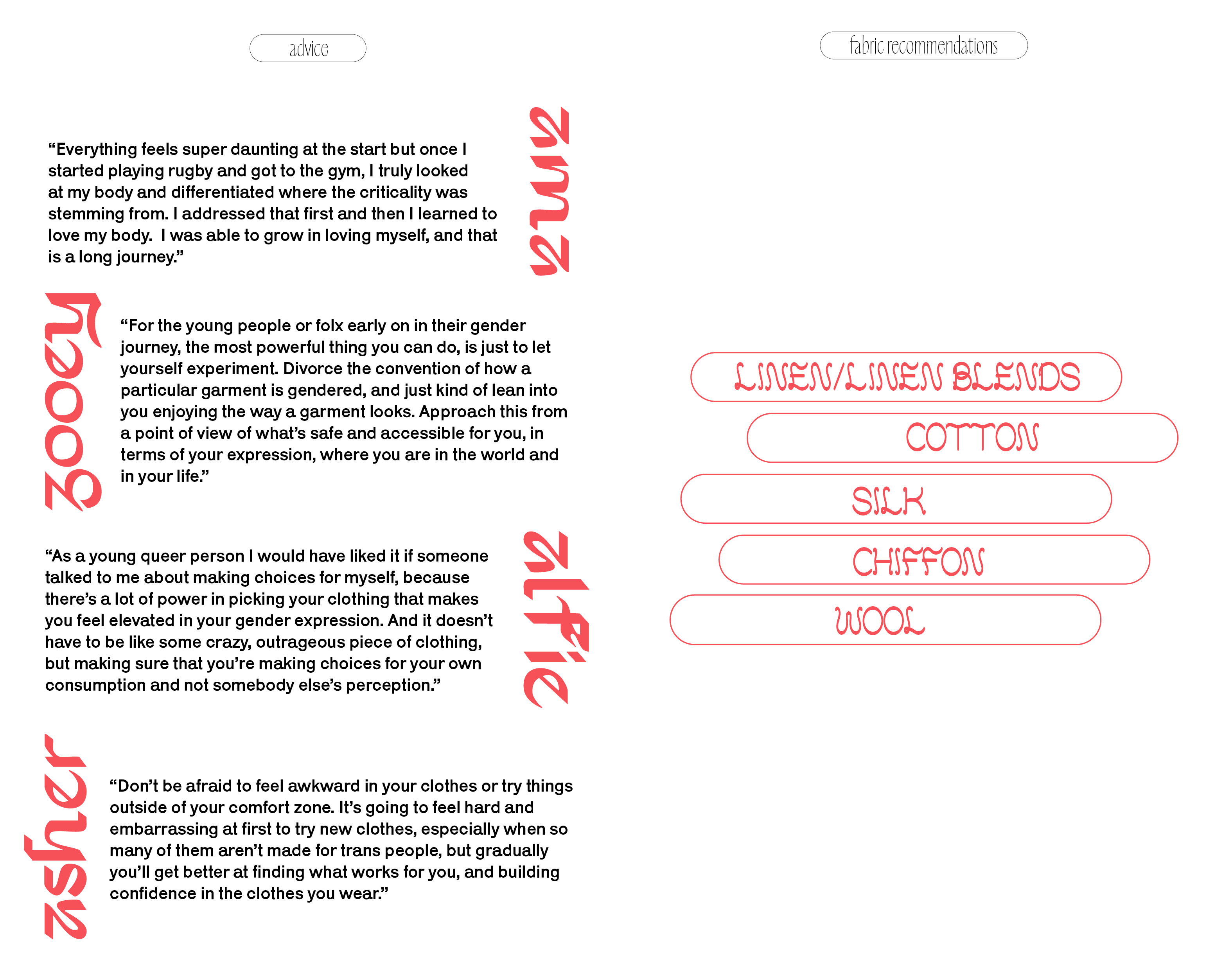


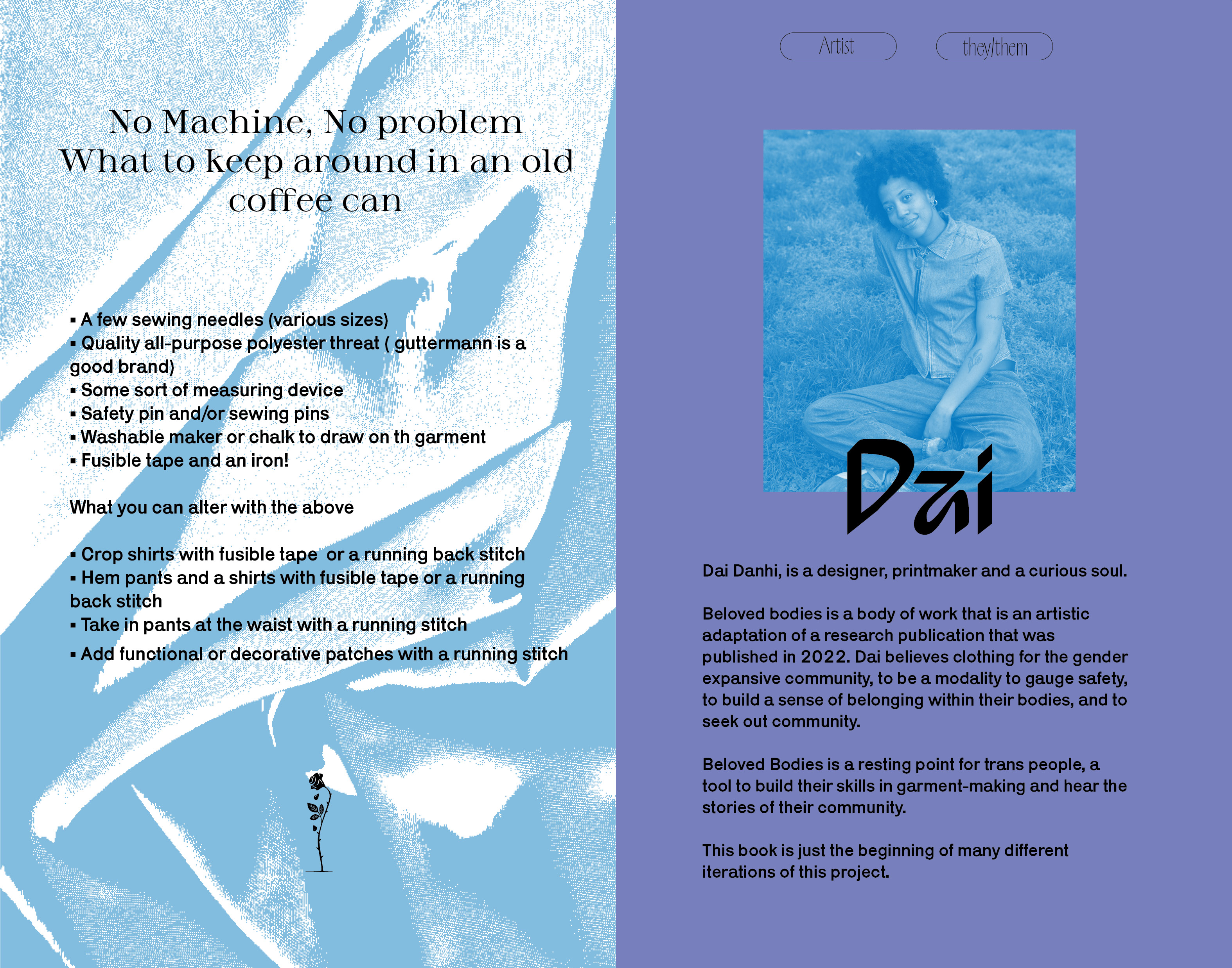

︎Baltimore, Maryland
Role : Researcher
Skills:
Ethographic Research
Conducting group listening sessions
1:1 interviews
Brainstorm session facilitation
Design Methods Used:
Group and 1:1 Interviews
User Testing
In field prototyping
Card sorting
Outcome:
Faciltated 3 Community Shareback sessions, 2 of which tested low fidelity protoypes on-site and gained feedback from CNH staff and faculty members. users which informed hte nest iteratation.
Designed a lesson plan template for CNH staff.
Design Sprint
Partnership: Center of Social Design and City Neighbours Hamilton
CNH is a public charter school consisting of an elementary school, middle school, and high school located in Bel-Air Baltimore City. This 3-week design sprint was tasked with understanding the current culture of City Neighbor Hamilton. The school realized that it had to pivot, needing to redefine what the “CNH way” is during a time of remote and in-school learning.
My team was specifically tasked with working with the teachers and staff. Having many on-site visits and group interviews with teachers of different grade levels in addition to staff members ranging from facilities to cafeteria staff and after-school care. Students were at the center of rebuilding the community culture at CNH, our prototypes focused on the time efficiency of daily curriculum and emotional development. Prototyping a lesson plan template with student input as well as an emotional restoration card set.
We presented our findings virtually to the school with possible avenues for future implementation to reignite community care within CNH culture.
Frame & Plan ︎︎︎ Research ︎︎︎ Sythesis ︎︎︎ Ideate ︎︎︎Prototype ︎︎︎ Implement and iterate
Design Challenge
How might we better utilize all staff to cultivate a new culture at City Neighbors Hamilton?
Sprint Team:
Teachers and StaffTasked with working with teachers and staff to specifically understand how they contribute to the current culture at CNH and how they define what the “CNH way” is for their students and community.
Context
With students ranging from high schoolers to kindergarteners entering a post - COVID school year, the school needed to re-evaluate what the essence of CNH is regarding new covid protocols and work/life balance among its’ staff and the social and emotional reset for their students.

Research
Listening sessions & Observing
We gained insight on the teachers perspective on the cultural changes taking place at CNH post COVID-19 and how thier interactions with thier students have shifted. Shifting from a role that not only provied genuine care but to a place of cautious distance and needing to understand thier stundents in a new frame. These interviews provided us with personal accounts of how COVID-19 has shaped their methods of teaching, consequently altering relationships between students and staff.
Synthesis
Themes:
Decision-making process around curriculum across grades
Navigating emotions amongst student conflict
Utilizing all staff members to manage after school activities

Protoyping
Collaborated with teachers on prototyping an outline to streamline the decision-making process for the school year curriculum and mocked up and tested emotional restoration cards for student conflict.
The prototypes were later presented to the head of administration after a week of user testing.
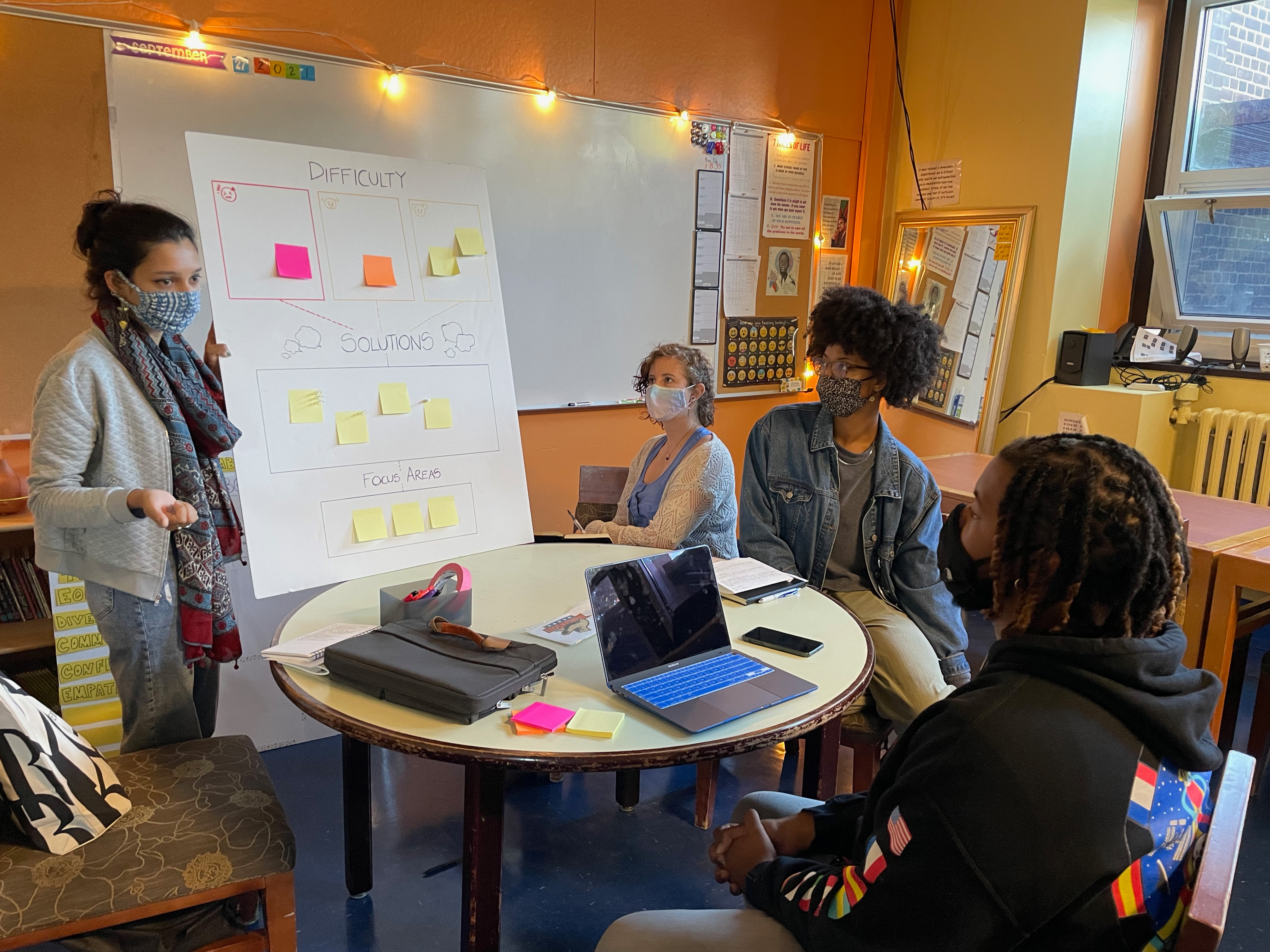

2023 - 2024
︎Baltimore, Maryland
Role:
Lead Social Design Researcher and Faciltiator
Skills:
Liberatory Design
Learning Experience Design
Human-Centered Design
Outcome:
Phase I: Curriculum Redesign
Phase 2: Community Asset Mapping Strategy
Tools and Methods Used:
Phase I:
Ethnographic research
Persona Building
Group Interviews
Journey Mapping
Equity-Centered Principal Pipeline Initiative
MICA’s Practice-Based Studios in Partnership with Morgan State University
The Equity-Centered Principal Pipeline initiative is a partnership between Baltimore City Schools(the District), Morgan State University’s School of Education and Urban Studies (S.U.E.S.), and the Maryland State Department of Education, funded by the Wallace Foundation. One of 8 districts across the country granted an 8.3 million dollar grant from the Wallace Foundation, this 5-year initiative focuses on understanding leadership in Baltimore Public Schools and its relationship to the equity-centered principal pipeline. The Wallace Foundation defines a principal pipeline as a districtwide strategy to develop a large, ongoing supply of effective school leaders.
Findings from the Social Design course will inform the larger Wallace work for the District. The work in this course will help shape the district’s definition of an equity-centered leader. This definition will be informed by the needs and wants of the broader community around Baltimore Public Schools, influencing the creation of a pipeline that can produce school leaders capable of addressing the intimate needs of Baltimore City students, teachers, parents, faculty, and community members.
Users: Morgan State University S.U.E.S graduates, faculty and administration, and current Baltimore City Public School leaders and their school’s community
Phase I: Spring/Summer of 2023 Objectives
The Social Design team is working collaboratively with our community partners to discover what Baltimore City’s vision of equitable leadership might be through a community-centered design process.
- Identify economic, social, political, and personal factors that impact equity in schools
- Understand the perspective of family members’ expectations of an equity-centered leader
- Describe the dispositions, characteristics, and mindsets of an equity-centered leader
Design Challenge: How might we define Equity-Centered Leadership within the Principal Pipeline?
Frame & Plan ︎︎︎ Research ︎︎︎ Sythesis ︎︎︎ Ideate ︎︎︎Prototype ︎︎︎ Implement and iterate
Phase I : Frame and Plan & Secondary Research Findings
Student Achievement & Student Wellbeing
One ultimate goal of the District and a strengthened principal pipeline is student achievement. However, this outcome may hinder the pursuit of overall student care and well-being.
Leadership and Context
Exemplary school leadership is defined as effective vision-setting, culture-building, instruction, and management of people, systems, and resources. However, we want the definition of school leadership to include the ability to understand, navigate, and manage the context, environment, and community in which schools exist.
Design Principles
Before my team and I began to investigate what is currently happening within Baltimore City Public Schools beyond theory, but in practice throughout BCPS, the team understood they needed to undergo a mindset reset. Recognizing implicit biases, they hold and work to address them before interacting with our key community partners.
To address the team’s individual and group biases, we partnered with David Clifford, a co-creator of Liberatory Design. A vital goal of this practice is to generate self-awareness and liberate designers from habits that perpetuate inequity within their design process. Throughout the semester, we participated in a series of self-awareness exercises using the Liberatory Design workbook. During their time with David, my team identified key design mindsets that were guidelines for holding ourselves in the field. The Liberatory mindsets discussed later defined our design principles for engaging our stakeholders.
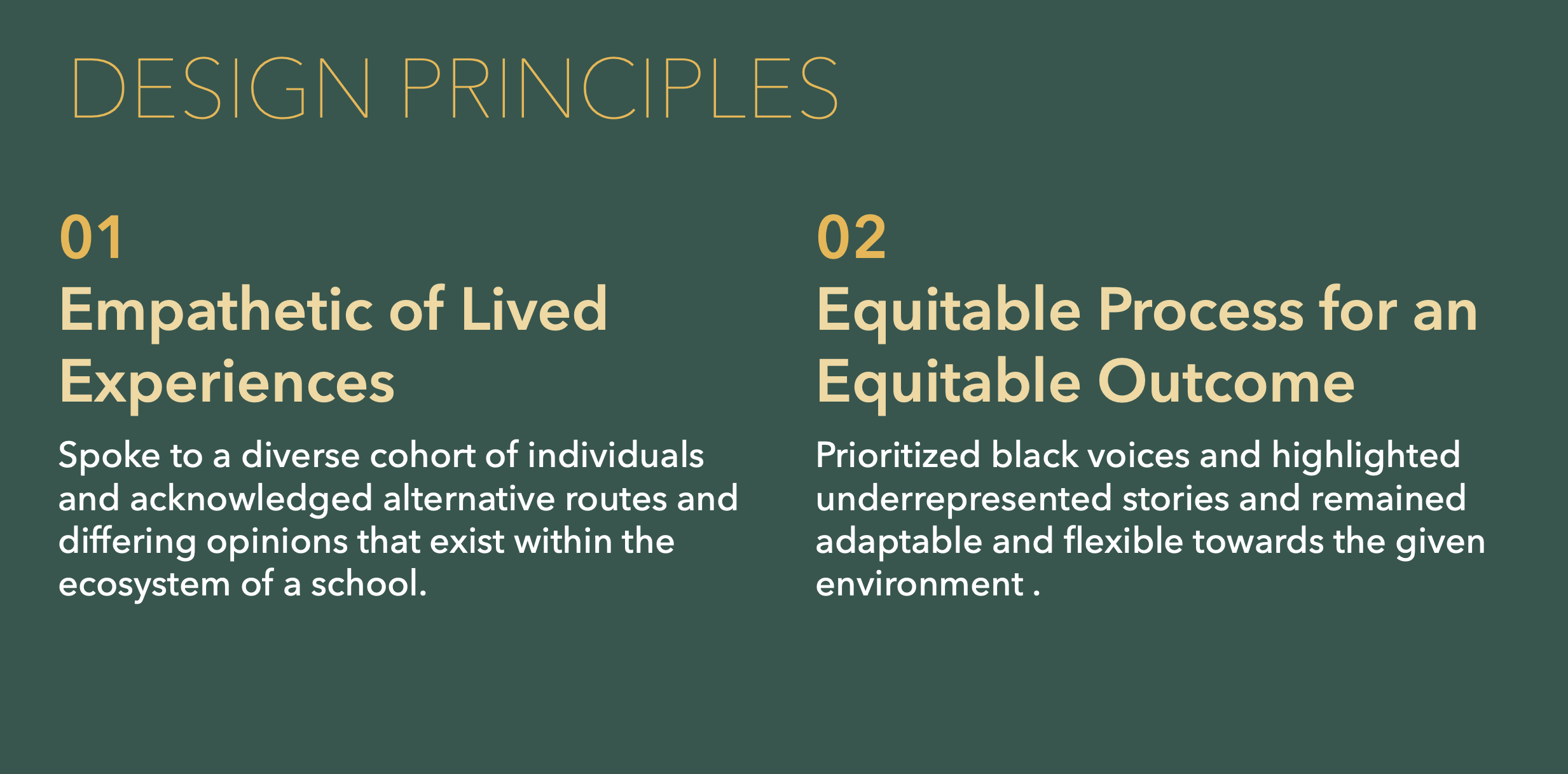
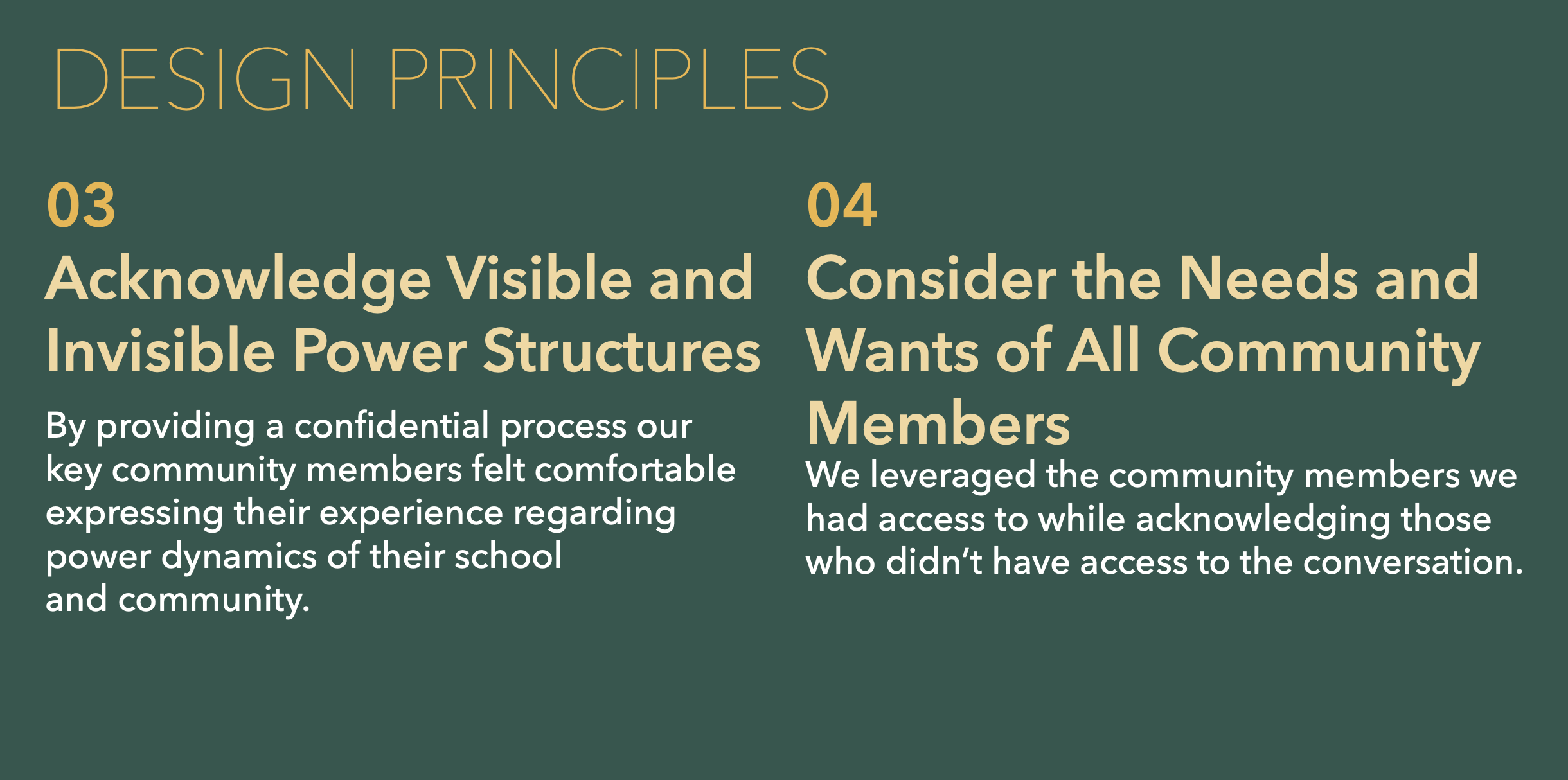




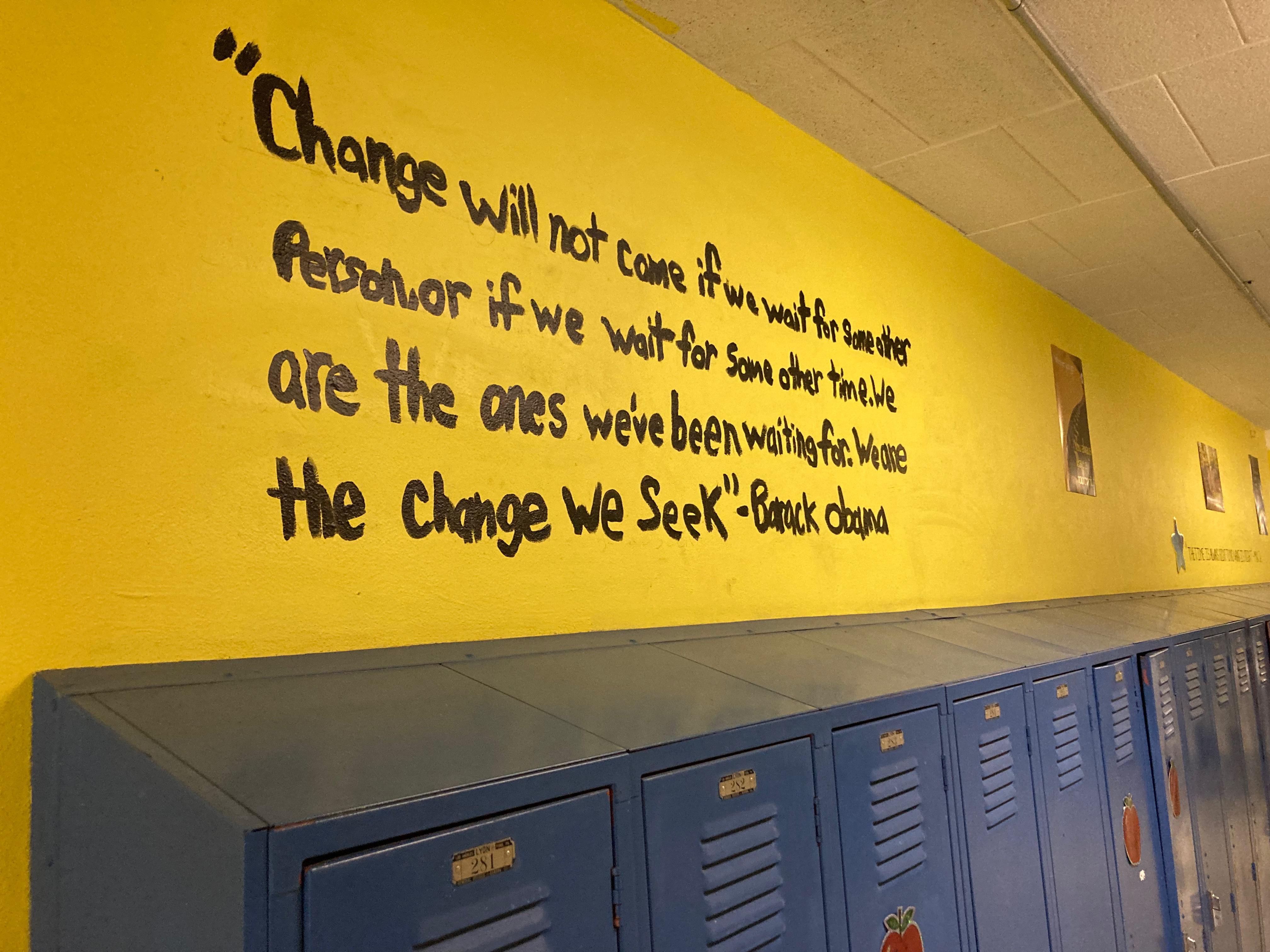
6 School and Community Visits
24 conversations
Reviewed 30 reports & articles
900 data points collected


Research
Methods
Guided Activity
Journey Mapping:
Conducted Journey Mapping activity with Principals, Assistant Principals and candidates on the pipeline to help facilitate a converstion around their academic experience and leadership journey.
This activity engaged Baltimore City Public School leaders as professionals who have gone through a system that has equipped them with the tools nessasary to lead their schools, but also engaged them as people, wanting to understand how their personhood affects their leadership skills and how their personal lives existed concurrently while on the pipeline to leadership.
︎
Interviews
Engaged in one-on-one discussions and group interviews with teachers, staff, community organizations and parents. During these interviews we unearthed the following tension:
- Student and teacher wellbeing
- Family/neighborhood outreach programs to help connect the schools families with nessasary resources
- Climate managment when addressing student’s lived expierence outside of the school effecting their learning enviourment within the school.
- Student and teacher wellbeing
- Family/neighborhood outreach programs to help connect the schools families with nessasary resources
- Climate managment when addressing student’s lived expierence outside of the school effecting their learning enviourment within the school.
Journey Map Synthesis
Post Interview Discussion
Observational Visits
︎
︎
Liberatory Design Workshops
We utilze Liberatory mindsets and modes to refelct on the Social Design teams identities in effort to build trust with our community partners to create a design process that is transformational and not transactional.
I co-facilitaed Liberatory Design workshops with Morgan State’s School of Education and Urban Studies, engaging faculty, adminstration and students. By understanding we are working in a liberating space, dealing with education and equity, we shared our expertise in teaching the S.E.U.S. program new ways to practice self awareness and empathy building through how they lead.
As a Design Researcher and Liberatory Design practioner, I know I do not solely hold the power to faciltiate change, but I do have the ability to share my knowledge and tools I use with my community partners to faciltiate change together.





What did we learn?


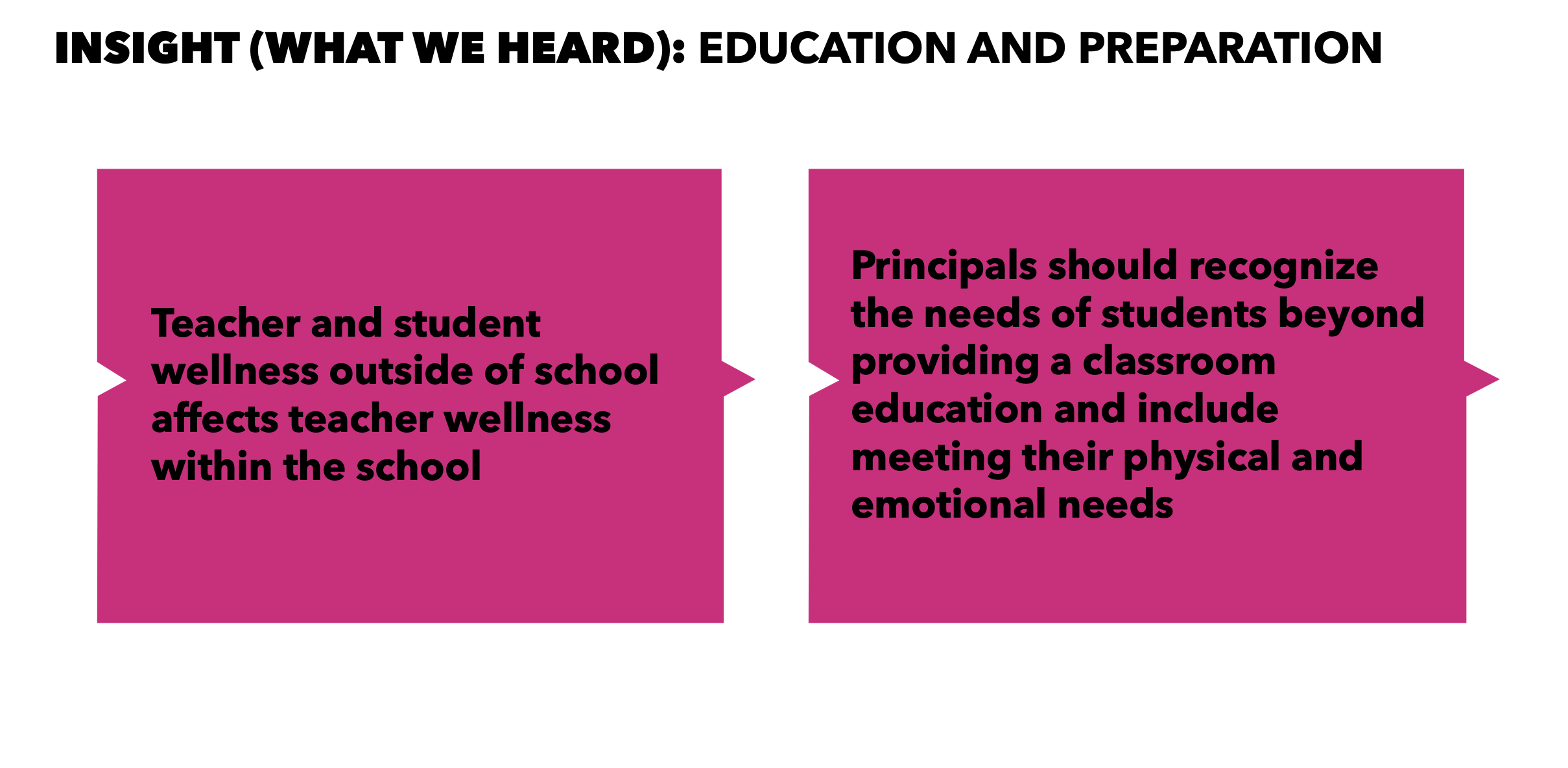
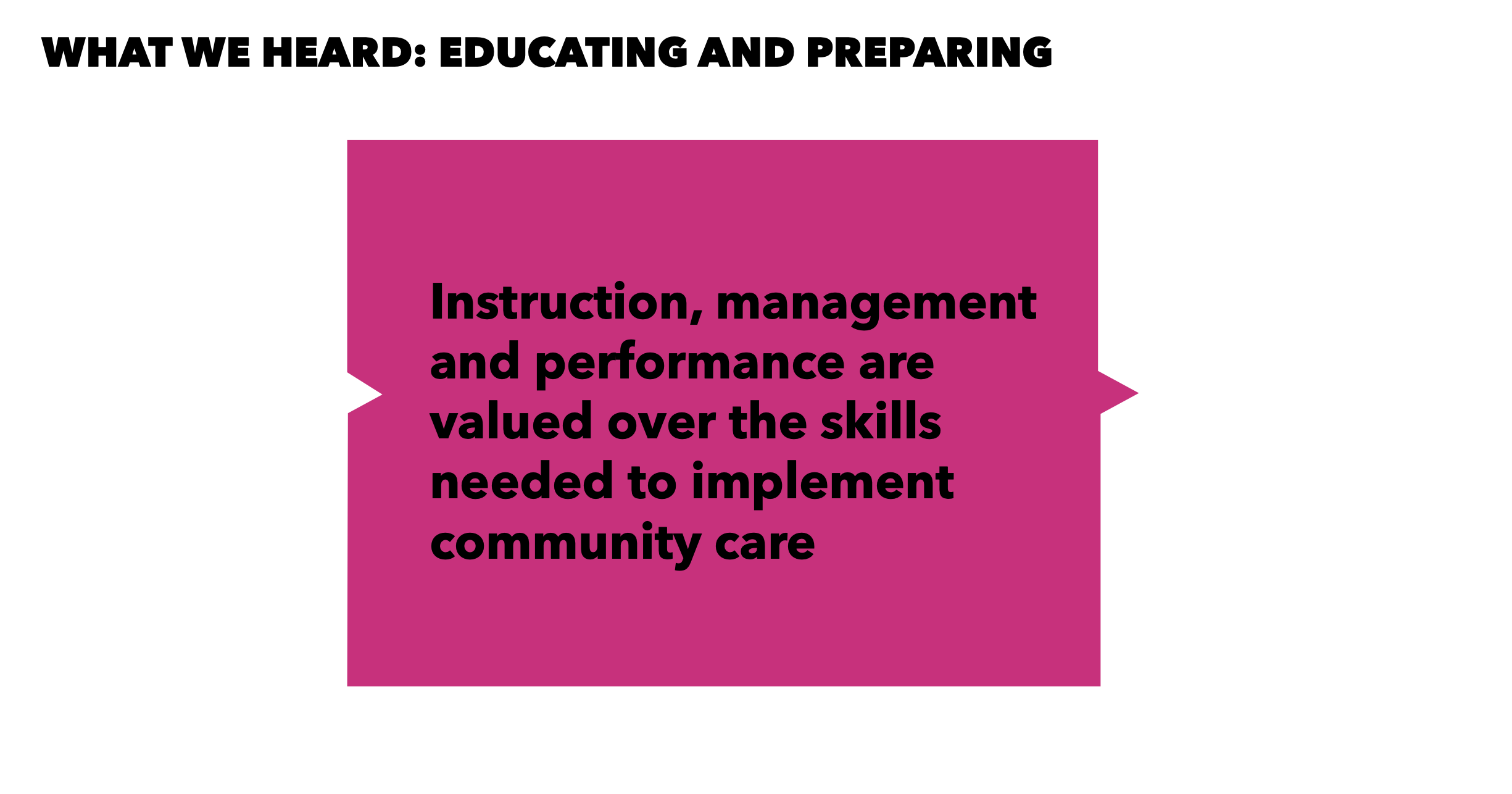




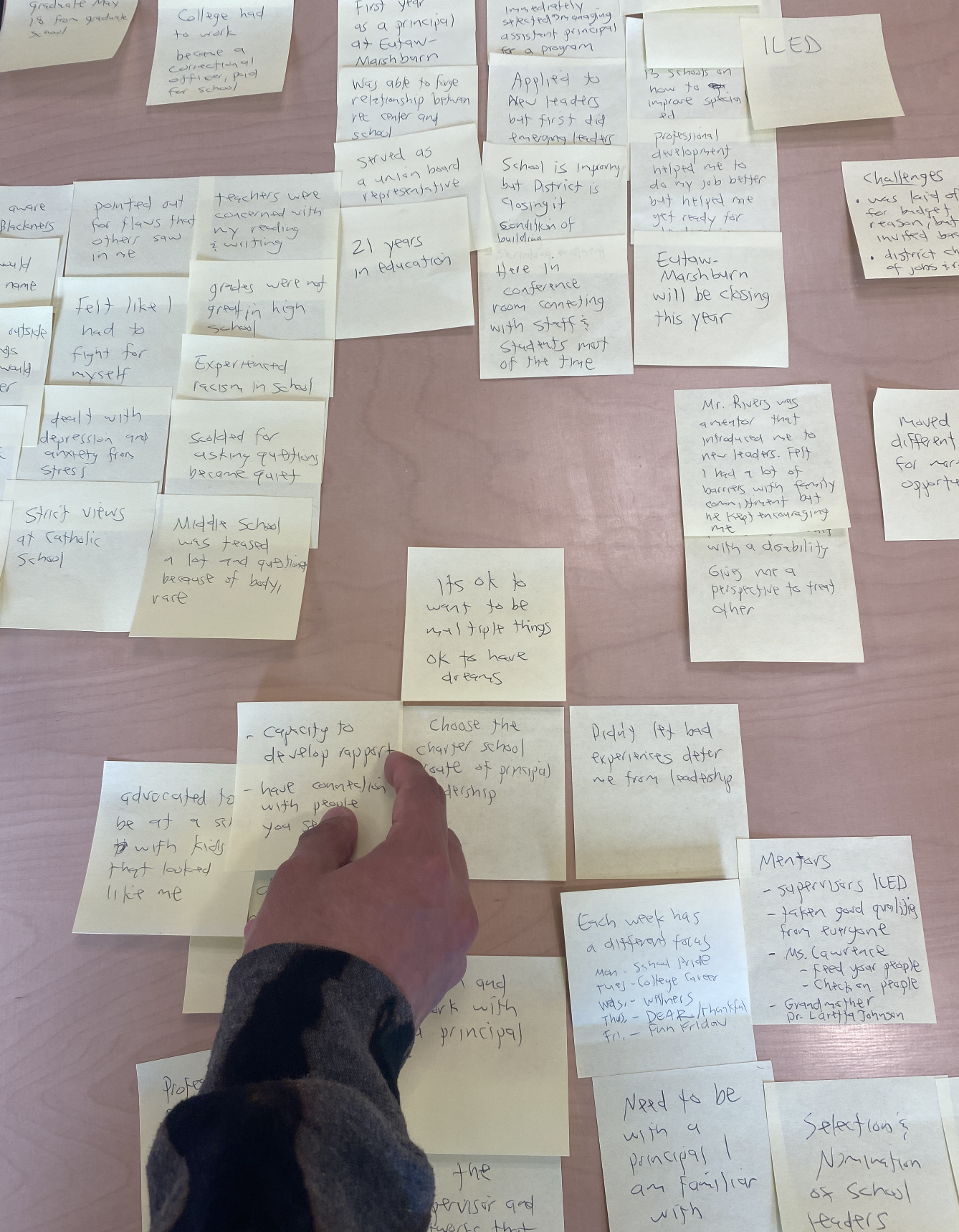

Where can opportunity exist?


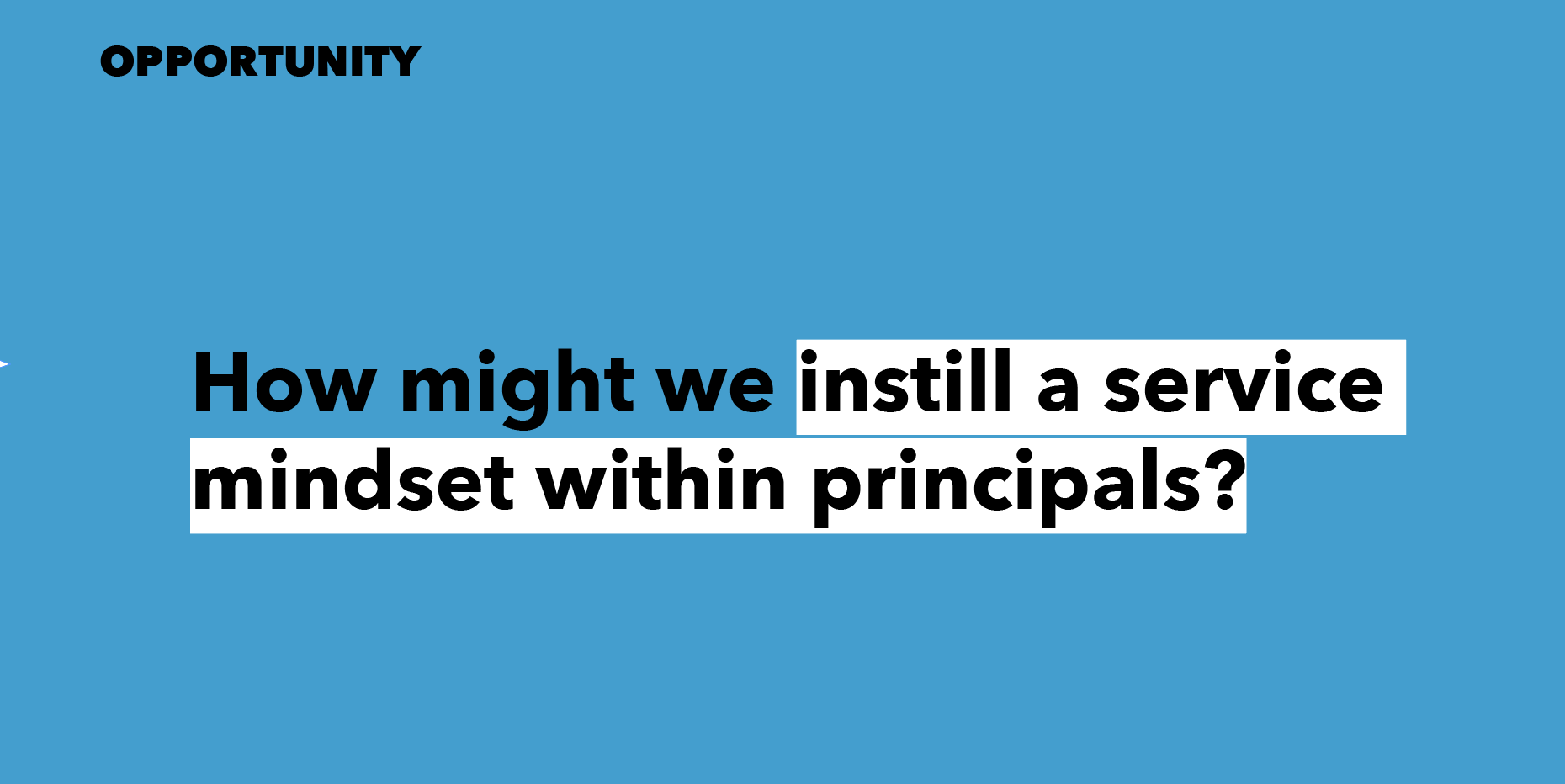



Tools and Methods Used:
Phase II:
Guided Activities:
Community Asset Mapping Tool and Community Dream Box
Phase II:
Guided Activities:
Community Asset Mapping Tool and Community Dream Box
Equity-Centered Principal Pipeline Initiative
MICA’s Practice-Based Studios in Partnership with Morgan State University
Phase II Area of Focus:
Focusing on the findings from Phase I, this new cohort of students making up the Social Design team in Phase II understood that equitable leadership did not solely depend on the characteristics of BCPS’s leaders but is significantly informed by the specific needs of their school’s neighborhood and the families who attended their school.
The phase primarily focused on the intersection of these three components: leadership, neighborhood, and family needs. The Social Design team partnered with Montebello Elementary and Middle School to learn from the school’s families and the broader Coldstream Homestead Montebello community to get a clear picture of how leadership is molded to support the entire ecosystem and community.
Reseach Objectives
- What are the community assets of each school's ecosystem?
- Why are those assets of value to Glenmont and Montebello families and their surrounding community?
- How do these families and community members seek out these resources?
Design Challenge: How might we develop and support leaders to leverage community assets to help better children, schools, staff, community needs, and school wellness?
Human-Centered Design Process:
Frame & Plan ︎︎︎ Research ︎︎︎ Sythesis ︎︎︎ Ideate ︎︎︎Prototype ︎︎︎ Implement and iterate
Frame and Plan: Shifting the focus from leadership to families
To understand the work that must be done to practice equitable leadership the Social Design Team understood Equity as a working model influenced by certain governing forces present, the lived experience of the people, and the context of the place.
This cohort was focused on how the local neighborhood and the school’s families demonstrate equity in and around their neighborhoods.
This cohort was focused on how the local neighborhood and the school’s families demonstrate equity in and around their neighborhoods.
Presence of Liberatory Design in Phase II:
Before primary research for Phase II could begin, this new team needed to undergo the same self-awareness series as the previous cohort. With a new team came a different set of biases, and with a new set of objectives came a new set of Liberatory Mindsets that needed to be upheld throughout the Human-Centered Design process.
With our key stakeholders shifting from principals to families and broader community members, we needed to shift our design principles and place our focus on this particular Liberatory Design Mindset, Build Realtional Trust.

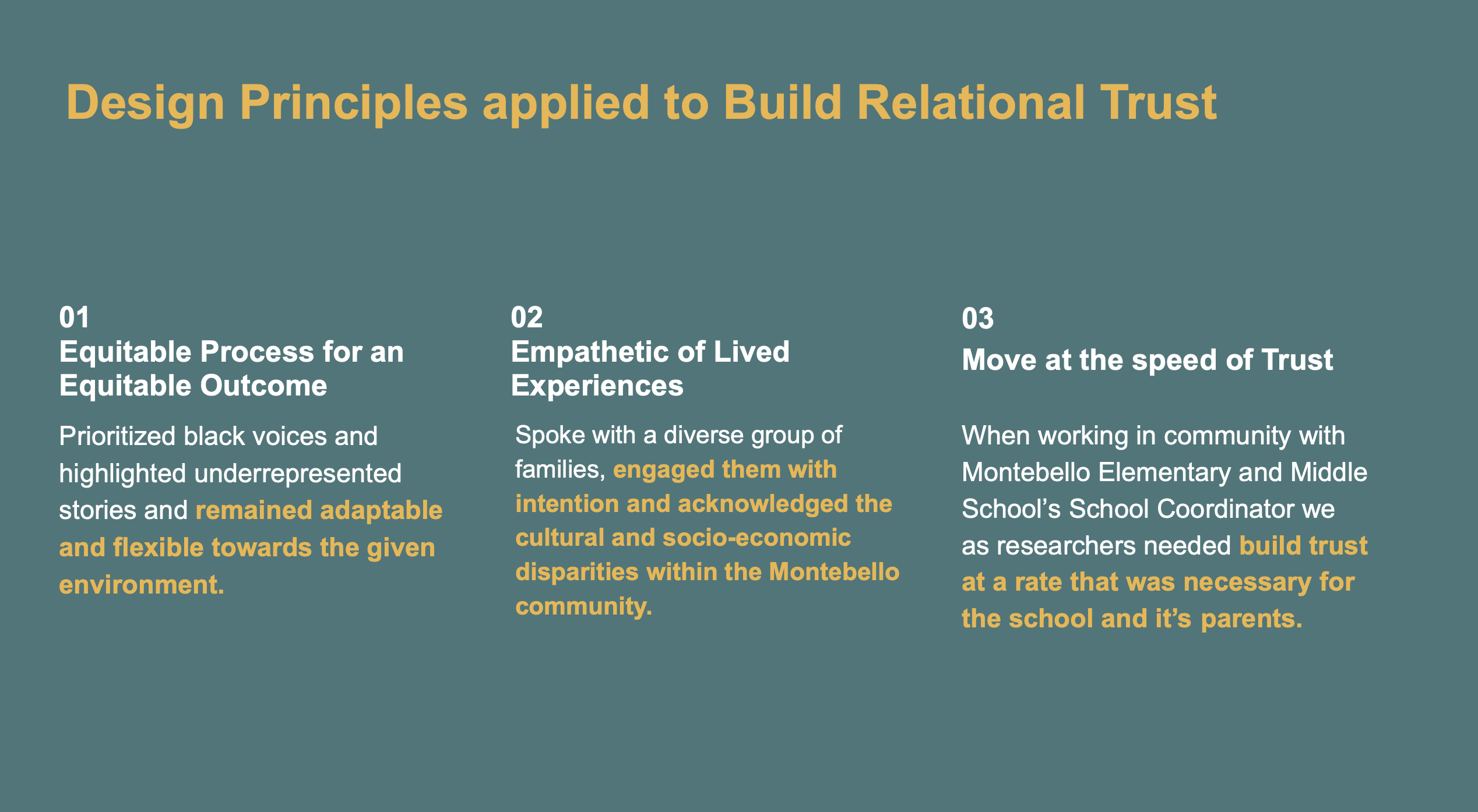
How we engaged Montebello families:
Montebello’s Community Coordinator allowed us to conduct a community engagement session at Montebello Elementary and Middle School on the same day as BGE's Day of Giving. During the event, families had the opportunity to connect with housing programs and receive assistance with energy bills through the support of BGE and local housing organizations. Here, we could engage with parents and hear their perspectives on the location of community assets inside and outside Montebello while they actively accessed the assistance they needed.
Research Method: Guided Activity
Community Dream Box:
Purpose: The Community Dream boxes prompted parents/caregivers to activate their imagination. Allowing them to express their needs from an imaginative state without putting limits on what they have access to currently
We asked:
What Resources or support do you wish the school had to support parents and caregivers?
︎
Map My Community:
Purpose: The mapping activity allowed parents/caregivers to see their neighborhood on a larger scale and mark their responses on the map with a green, blue, or yellow sticker corresponding to the question.
This activity encouraged parents/caregivers to interact with their community tactilely.
We asked 3 questions:
- What do you like about the neighborhoods surrounding Montebello?
- Where do you get supplies and support for your child/family? (food, clothing, cleaning supplies)
- Where do you go to receive resources outside of the school that support your child's success?

Next Steps:
The MICA Social Design team successfully fulfilled the community engagement objectives of the Equity-Centered Principal Pipeline Initiative in the Spring of 2024. The team's findings from phases I and II will inform the curriculum redesign at Morgan State University’s School of Education and Urban Studies (S.E.U.S.) to help rebuild and reshape the leadership of Baltimore City Public Schools, particularly for principals and leaders who graduated from Morgan State's S.E.U.S. program.
2023
︎Baltimore, Maryland
Role:
Lead Facilitator + Designer
Skills:
Community Engagement
Presentation Design
Infographic Design
Facilitation
Outcome:
Created an iterative feedback loop between the architects and developers with West Baltimore residents.
Tools and Methods Used:
Community Forums
Focus Groups
Personas
Canvassing
Partners:
![]()
![]()
︎Baltimore, Maryland
Role:
Lead Facilitator + Designer
Skills:
Community Engagement
Presentation Design
Infographic Design
Facilitation
Outcome:
Created an iterative feedback loop between the architects and developers with West Baltimore residents.
Tools and Methods Used:
Community Forums
Focus Groups
Personas
Canvassing
Partners:


The Sanaa Cultural Arts Center Build
The Joltage team undertook a pivotal role in the development of the Sanaa Cultural Arts Center, acting as the crucial link between Drummond Architects, the Civic Group responsible for the build, and Intersection of Change and Black Arts Districts HQ, which is slated to occupy the space. Recognizing the significance of community engagement, our primary task was to weave the fabric of Upton community input into every facet of the project.
Upholding Upton community guidelines and valuing the input of the Uptown residents were at the core of our mission. To achieve this, we initiated a series of dynamic community forums designed as interactive platforms where the community could articulate their dreams and identify the resources necessary for the Sanaa Cultural Arts Center.
These forums served as a bridge, fostering open dialogue between the Uptown community, Sanaa Center developers, and architects. By creating a space where the developers and architects could converse and actively listen to the voices of the Upton community, we ensured that the building would only meet the residents’ expectations.
The goals & Objectives for collaboration with Drummond Architects, The Civic Group, The Black Arts District, and The Intersection of Change are to:
- Identify key community stakeholders and constituents.
- Create a community-based stakeholder and constituents advisory team to provide feedback and guidance.
- Inform and enroll stakeholders and constituents about the community engagement process and project.
Click here for information and how to donate to the Sanaa Center
Click here for updates on the build





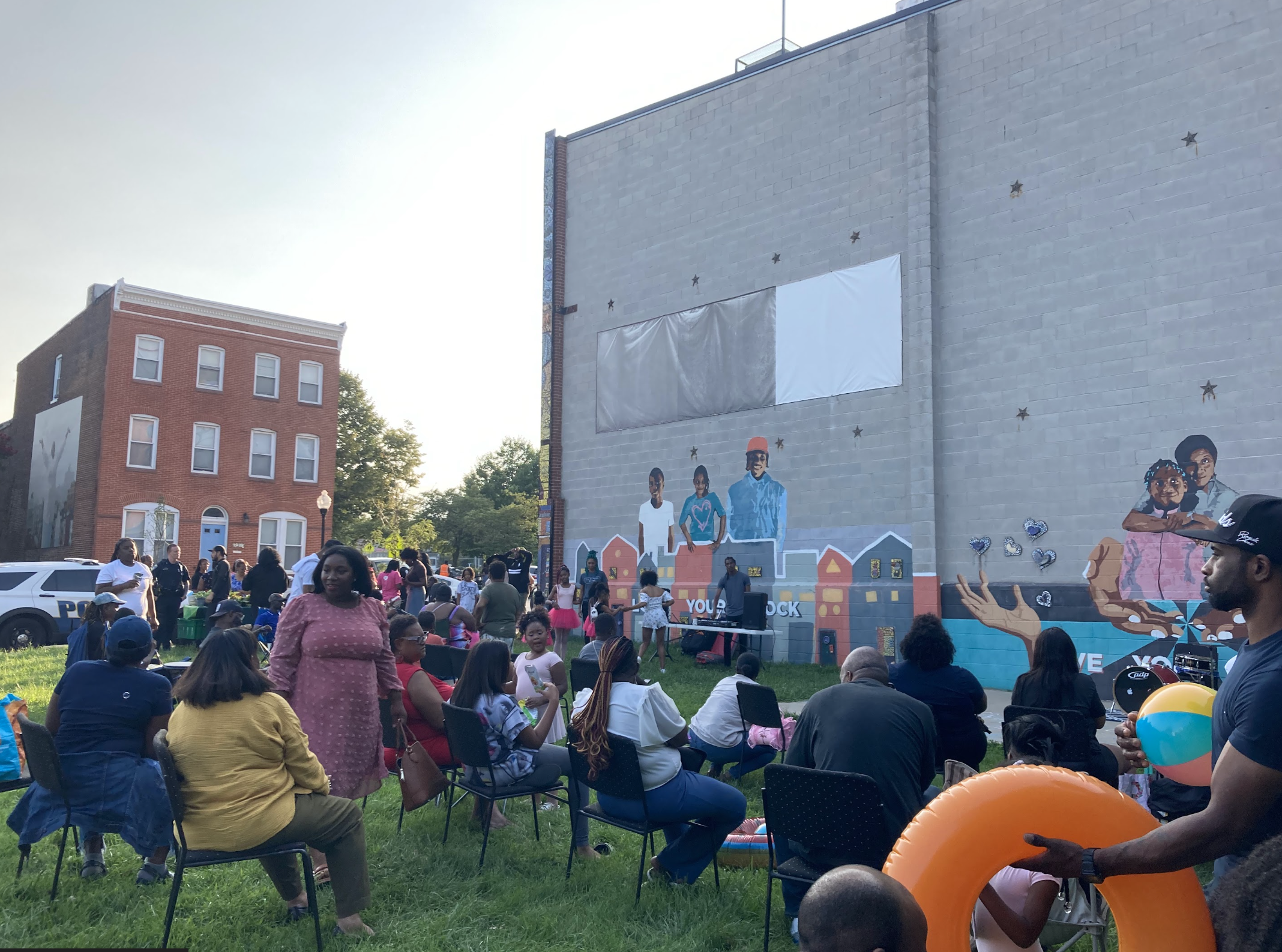
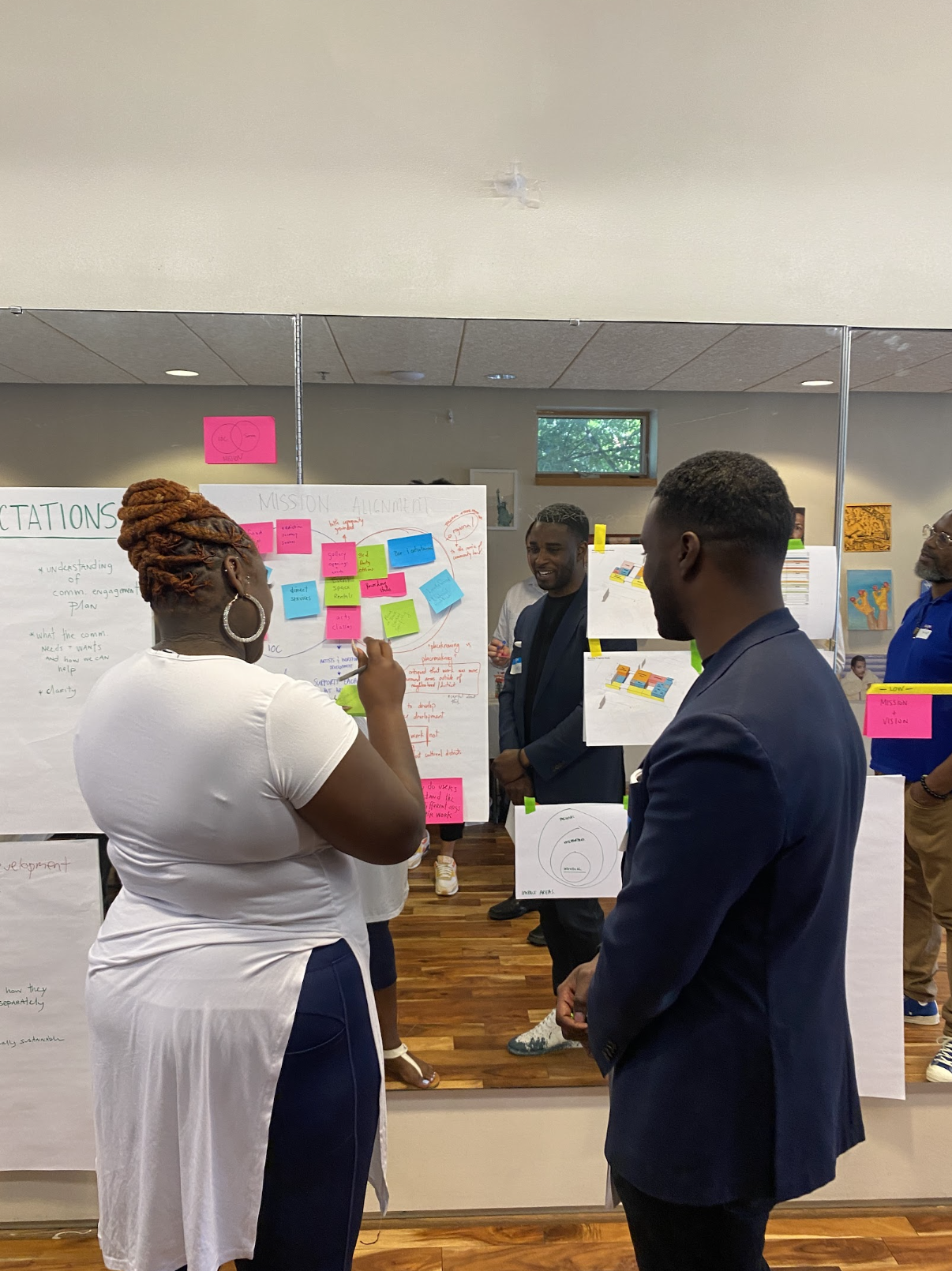
2021 - 2022
︎Baltimore, Maryland
Role:
Visual Designer
Design Researcher
Community Facilitator
Skills:
Empathic Interviewing
Strategic Thinking
Collabrative Brainstorming facilitation
Conducting Human-Centered Design Process
Presentation Design
Methods Used:
Ethnographic Research
1:1 Interviews
User Journey Mapping
A-B User testing
Persona Building
Outcome:
A wayfinding system for the BCHD Sexual Health Clinics.
A step-by-step guide of the PrEP Intiaition Process for clinians and patients to follow along together.
Designed communication materials for clinic staff: buisness cards, posters and info cards explianing clinic resources.
Streamline the PrEP Initiation process for PrEP Providers and Clinicians in Baltimore City’s Sexual Health Clinics
Partnership: Baltimore City Health Department
I utilized the HCD process to identify key insights and opportunities to see where the PrEP narrative lies within and outside of the clinic. The goal was to devise the implementation of a smoother initiation process for PrEP providers and clinicians. To retrieve this information, I interviewed key stakeholders 1:1 and group interviews with clinic directors, clinicians, providers, users of PrEP, those who no longer use PrEP, peer navigators, and potential users.
During the research phase, I uncovered the motives of outer community memeber and what they konow about PrEP. In discovering this information, I leveraged this information by collabrating with the clinics and see where they can better inform their community about how PrEP is administered at the clinic.
In gathering insights, I created a print campaign that laid out the PrEP Process step by step for patients and provided clinicians and providers with a guide on how to effectively pass along patients from clinician to provider. This campaign was rolled out in clinics in August 2022.
HCD Process:
Frame & Plan ︎︎︎ Research ︎︎︎ Synthesis ︎︎︎ Ideate ︎︎︎Prototype ︎︎︎ Implement and Iterate
Design Challenge
How might we support BCHD PrEP Providers and Clinicians with the initiation of PrEP?
Research
![]()
Research

Design Principles

Research
Methods
︎︎︎
Journey Mapping
To aid our understanding, we created two journey maps. These maps followed the PrEP initiation process from STI clinicians to PrEP providers alongside their patients, grounding us in the project and creating a genuine connection between us and our stakeholders.
In mapping the patient's experience alongside the PrEP protocol, we saw the pain points that emerged and the opportunities for both the patient and the provider.
︎
Interviews
Engaged in 1:1 interviews with BCHD patients who are currently on PrEP and patients who have discontinued their use of PrEP. During these discussions, we heard various stories from patients recalling their first memories associated with when they first began taking PrEP.
Synthesis

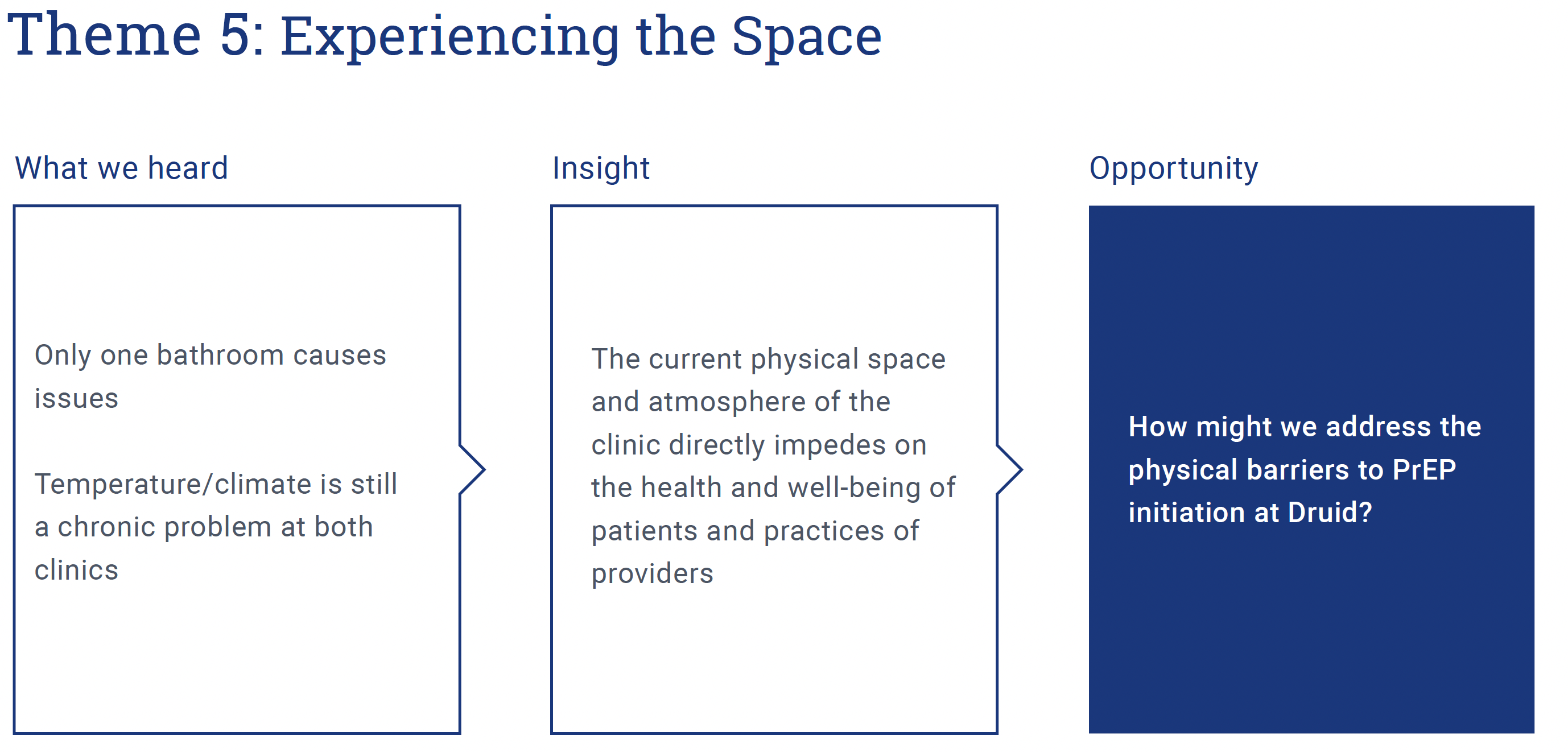


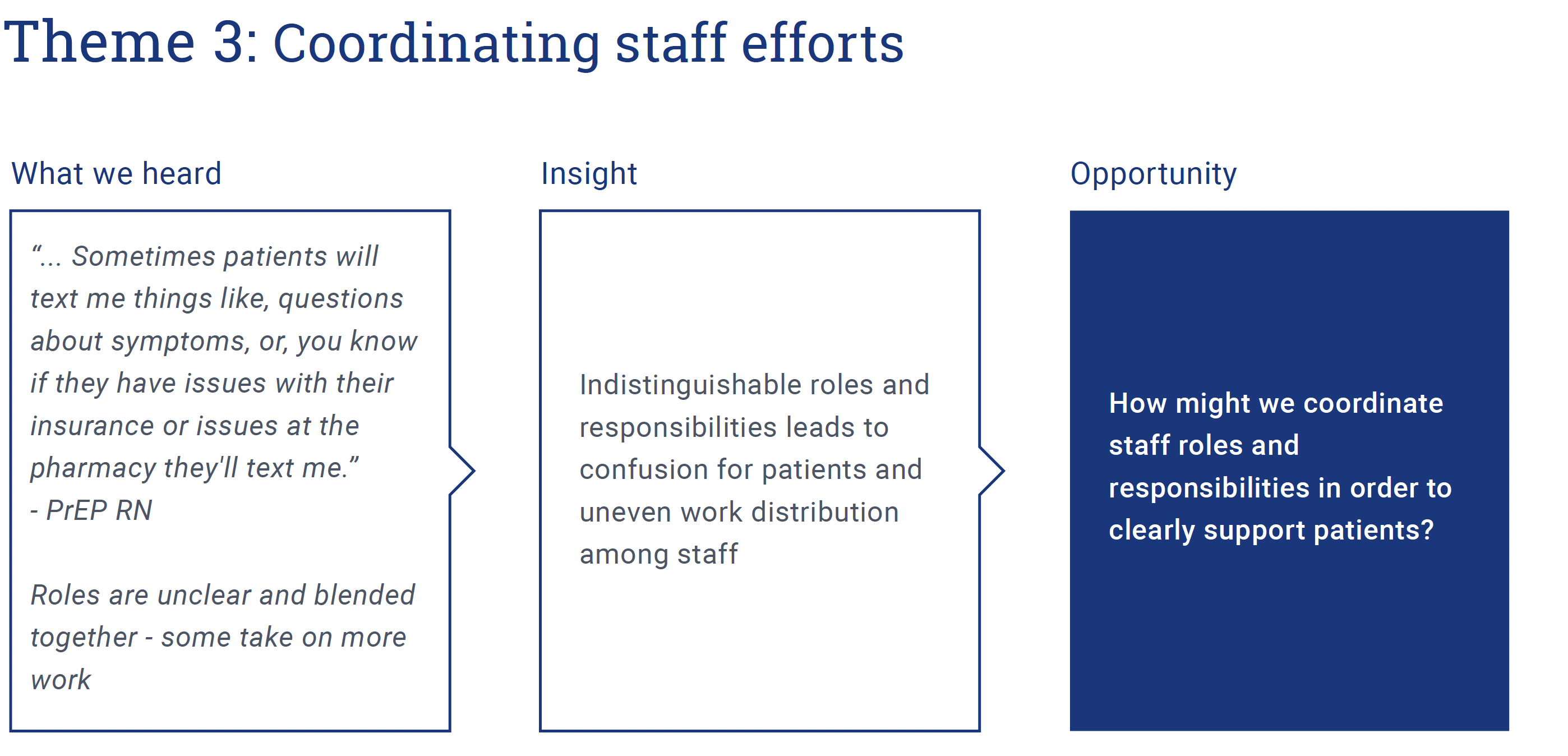
Ideation
We held co-creation sessions with providers, patients, clinicians, and BCHD administration to brainstorm the opportunities presented during synthesis. After gathering their ideas, we categorized them according to utility and need.
︎︎︎
Prototype
Multiple ideas were prototyped and narrowed down as providers and patients gave feedback. Moving forward, we created higher fidelity prototypes, tested them with BCHD staff, and shared them with patients. Both parties gave us feedback, which led us to refine our prototypes. We went through 2 rounds of user testing, receiving more feedback for iterative testing.
Ideation
︎︎︎
Prototype

